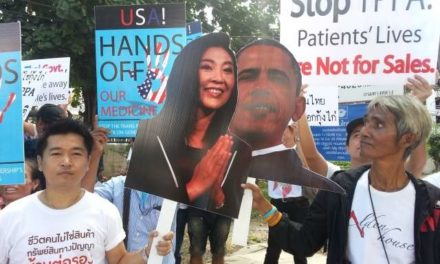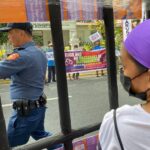The bane of Southeast Asian tiger economies is due to their rapid industrialisation strategy which is highly dependent on foreign capital, argues Walden Bello in this first of a three-part series.
The environmental community received an early Christmas gift a few weeks ago when the Malaysian government announced that it was suspending plans to build the controversial Bakun dam in Sarawak. Constructing the dam would have resulted in the clear-cutting of close to 70,000 hectares of forest land in an area that is already experiencing one of the world’s highest rates of deforestation and the displacement of about 9,500 indigenous people.
What years of international and local pressure on the Malaysian government could not do was achieved by the one message that the country’s strong-willed leader, Mohamad Mahathir, could understand — no more dollars. Expected to cost US$5 billion, the Bakun dam — like Mahathir’s other vision of building a 2 km-long ”Linear City” that would have been the world’s longest building — fell victim to the financial crisis that is presently wrecking Southeast Asia.
In the last three and-a-half months, Southeast Asia has been gripped by an economic downspin that has yet to hit bottom. Stock markets from Jakarta to Manila have hit record lows — to which they have dragged, via the curious ”contagion effect”, Hong Kong and even Wall Street, at least momentarily.
Governments throughout the region are paralysed by the crisis. In the Philippines, the administration of President Fidel Ramos is reduced to telling the people to count their blessings because the crisis is worse in Thailand, Malaysia and Indonesia. In Kuala Lumpur, Mahathir rails angrily against what he sees as a conspiracy to debauch Southeast Asia’s currencies led by speculator George Soros.
Draconian programmes
Once proud of their freedom from the International Monetary Fund’s (IMF) stabilisation and structural adjustment programme, the Thai and Indonesian governments have run to this global bank, which has assembled massive multi-billion dollar bail-out funds in return for draconian programmes that pull the plug from banks and finance companies, mandate deep spending cuts, and accelerate liberalisation and deregulation in economies marked by significant state intervention.
The Philippines never left IMF management, and it is now likely to postpone its ”exit” from the fund. True to form, Malaysia’s Mahathir refuses to go to an institution that he sees as part of the problem rather than the solution.
Many informed analysts, while dismissing Mahathir’s conspiracy theories, have pinned part of the blame for the crisis on the uncontrolled flow of trillions of dollars across borders owning to the globalisation of financial markets over the last few years.
Increasingly, some assert, capital movements have become irrational and motivated by no more than a herd-like mentality, where one follows the movement of ”lead” fund managers like Soros, without really knowing about the ”economic fundamentals” of regions they are coming to or withdrawing from.
Surprising, Stanley Fischer, the IMF deputy managing director, lent support to this interpretation when he told the recent World Bank-IMF annual meeting in Hong Kong that ”markets are not always right, sometimes inflows are excessive, and sometimes they may be sustained too long. Markets tend to react late: but then they tend to react fast, sometimes excessively”.
For most progressive analysts, however, this explanation merely begs the real issue, and this is a pattern of development that has rendered the region very vulnerable to such foreign capital inflows and outflows. In their view, the current turmoil in the region’s economies is the inevitable result of the closer integration of the region’s economy into the global economy.
It is a crisis that is largely self-created, being the unravelling of an economic model that rested on the illusion that, as the Business Times of Singapore put it, ”countries could leapfrog the normally long and arduous course to advanced country status simply by maximising their access to foreign capital inflows”.
Massive inflow
More than in the case of the original newly industrialising countries (NICs) of Northeast Asia, the Southeast Asian NICs have been dependent for their economic growth on foreign capital inflows. The first phase of this process of foreign capital-dependent growth occurred between the mid-eighties and the early nineties when a massive inflow of capital from Japan occurred, lifting the region out of recession and triggering a decade of high seven to 10 per cent GDP growth rates that were the envy of the rest of the world.
Central to this development was the Plaza Accord of 1985, which drastically revalued the yen relative to the dollar, forcing the Japanese to seek low-cost production sites outside Japan so they could remain globally competitive. Some US$15 billion in Japanese direct investment flowed into the region between 1986 and 1990. This infusion brought with it not only billions more in Japanese aid and bank capital but also an ancillary flow of capital from first generation NICs of Taiwan, Korea and Hong Kong.
By providing an alternative access to tremendous sums of capital, Japanese investment had another important result: it enabled Southeast Asian countries to slow down the efforts of the IMF and World Bank to carry out the wide-ranging ”structural adjustment” of their economies in the direction of greater trade liberalisation, deregulation and privatisation — something that the Bretton Woods institutions had successfully imposed on Latin America and Africa.
By the early 1990s, however, Japanese direct investment inflows were levelling off or, as in the case of Thailand, falling. By that time, however, Southeast Asian countries had become addicted to foreign capital.
The challenge confronting the political and economic elites of Southeast Asia was how to bridge the massive gap between the limited saving and investments of Asean countries and the massive investment they needed for their strategy of ”fast track capitalism” that, in their view, would bring about the happy union of prosperity for them, economic upliftment for the lower classes via a trickling down of GNP growth, and political stability for the whole country.
But happily for them, a second source of foreign capital opened up in the early 1990s, and this was the vast amounts of personal savings, pension funds, corporate savings and other funds that were deposited in mutual funds and other investment institutions that sought to maximise their value by placing them in highly profitable ventures. These funds were largely American.
In the early 1990s, noted an Asian Development Bank report, ”the declining returns in the stock markets of industrial countries and the low real interest rates compelled investors to seek higher returns on their capital elsewhere”.
Come-hither strategies
These funds were not, however, going to come in automatically without a congenial investment climate. To attract these funds, financial managers throughout Southeast Asia devised come-hither strategies that had the same three central elements:
* First, financial liberalisation, or the elimination of foreign exchange and other restrictions on the inflow and outflow of capital, fully opening up stock exchanges to the participation of foreign portfolio investors, allowing foreign banks to participate more fully in domestic banking operations, and opening up other financial sectors, like the insurance industry, to foreign players.
* Second, maintaining high domestic interest rates relative to interest in the US and other world financial centres in order to attract speculative capital that would seek to capture the enormous difference from the spread between, say, interest rates of five to six per cent in New York and rates of 12 to 15 per cent in Manila or Bangkok.
* Third, fixing the exchange rate between the local currency and the dollar to eliminate or reduce risks for foreign investors stemming from the fluctuations in the value of what were viewed as the region’s ”soft currencies”. This guarantee was needed if investors were going to come in, change their dollars into pesos, baht or rupiah, play the stock market or buy high-yielding government bonds, and transform their capital and their profits back into dollars and move on to other markets where more attractive opportunities awaited them.
Of course, there were variant mixes of financial liberalisation, interest and exchange rate policies in the four countries, nuanced by the varying appreciation of other factors such as inflation and recession on the part of different governments, but the thrust in the manipulation of these policy tools was in the same general direction. And the formula had the blessings of the IMF and the World Bank, where one of the key elements of neo-classical economic doctrine was capital account liberalisation.
This policy was wildly successful in achieving its objective of attracting foreign portfolio investment and bank capital. The Americans, in particular, were heavy players, with US mutual funds supplying net new capital to the region in the order to $4 to $5 billion a year for the past few years.
Part two: How this foreign-capital-driven ”fast track capitalism” led to profligate spending in Southeast Asia.
————-
Walden Bello, a contributing editor for The Nation, is professor of sociology and public administration at the University of the Philippines and co-director of Focus on the Global South at Chulalongkorn University’s Social Research Institute. He is author of nine books on East Asian economic and political issues, including the forthcoming ”A Siamese Tragedy: Development and Disaster in Modern-Day Thailand”.







